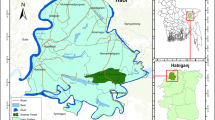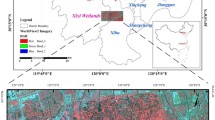Abstract
The Yellow River Delta wetland is the youngest wetland ecosystem in China’s warm temperate zone. To better understand how its landscape pattern has changed over time and the underlying factors responsible, this study analyzed the dynamic changes of wetlands using five Landsat series of images, namely MSS (Mulri Spectral Scanner), TM (Thematic Mapper), and OLI (Operational Land Imager) sensors in 1976, 1986, 1996, 2006, and 2016. Object-oriented classification and the combination of spatial and spectral features and both the Normalized Difference Vegetation Index (NDVI) and Normalized Difference Water Index (NDWI), as well as brightness characteristic indices, were used to classify the images in eCognition software. Landscape pattern changes in the Yellow River Delta over the past 40 years were then delineated using transition matrix and landscape index methods. Results show that: 1) from 1976 to 2016, the total area of wetlands in the study area decreased from 2594.76 to 2491.79 km2, while that of natural wetlands decreased by 954.03 km2 whereas human-made wetlands increased by 851.06 km2. 2) The transformation of natural wetlands was extensive: 31.34% of those covered by Suaeda heteropteras were transformed into reservoirs and ponds, and 24.71% with Phragmites australis coverage were transformed into dry farmland. Some human-made wetlands were transformed into non-wetlands types: 1.55% of reservoirs and ponds became construction land, and likewise 21.27% were transformed into dry farmland. 3) From 1976 to 2016, as the intensity of human activities increased, the number of landscape types in the study area continuously increased. Patches were scattered and more fragmented. The whole landscape became more complex. In short, over the past 40 years, the wetlands of the Yellow River Delta have been degraded, with the area of natural wetlands substantially reduced. Human activities were the dominant forces driving these changes in the Yellow River Delta.
Similar content being viewed by others
References
Chen Lin, Ren Chunying, Wang Chan et al., 2017. Dynamic of coastal wetlands of the Yellow River Delta for 6 periods. Wetland Science, 15(2): 179–186. (in Chinese)
Chen Yiyu, 1995. China Wetlands Research. Changchun: Jilin Science and Technology Publishing House, 1–2: 292–298. (in Chinese)
Dong J W, Xiao X M, Menarguez M A et al., 2016. Mapping paddy rice planting area in northeastern Asia with Landsat 8 images, phenology-based algorithm and Google Earth Engine. Remote Sensing of Environment, 185: 142–154. DOI: https://doi.org/10.1016/j.rse.2016.02.016
Dongying Government, 2018. Available via DIALOG. https://doi.org/www.dongying.gov.cn/html/2018-03/1803011675298959.html. Cited 15 March 2018. (in Chinese)
Escorihuel M J, Quintana-Segui P, 2016. Comparison of remote sensing and simulated soil moisture datasets in Mediterranean landscapes. Remote Sensing of Environment, 180: 99–114. DOI: https://doi.org/10.1016/j.rse.2016.02.046
Frohn R C, Reif M, Lane C et al., 2009. Satellite remote sensing of isolated wetlands using object-oriented classification of Landsat-7 data. Wetlands, 29(3): 931. DOI: https://doi.org/10.1672/08-194.1
Fu X, Liu G H, Chai S Y et al., 2013. Spatial-temporal analysis of wetland landscape pattern under the influence of artificial dykes in the Yellow River delta. Chinese Journal of Population Resources and Environment, 11(2): 109–117. DOI: https://doi.org/10.1080/10042857.2013.777204
Gai Zhenyu, 2011. The Study on Change of the Yellow River Delta Coastal under the Influence of Human Activities. Ji’nan: Shandong Normal University. (in Chinese)
Guo Q H, Kelly M, Gong P et al., 2007. An object-based classification approach in mapping tree mortality using high spatial resolution imagery. GIScience & Remote Sensing, 44(1): 24–47. DOI: https://doi.org/10.2747/1548-1603.44.1.24
Han Mei, Zhang Cui, Lu Guang et al., 2017. Response of wetland landscape pattern gradient to human activity intensity in Yellow River Delta. Transactions of the Chinese Society of Agricultural Engineering, 33(6): 265–274. (in Chinese)
Hong Jia, Lu Xiaoning, Wang Lingling, 2016. Quantitative analysis of the factors driving evolution in the Yellow River Delta Wetland in the past 40 years. Acta Ecologica Sinica, 36(4): 924–935. (in Chinese)
Liu J T, Feng Q L, Gong J H et al., 2016. Land-cover classification of the Yellow River Delta wetland based on multiple end-member spectral mixture analysis and a Random Forest classifier. International Journal of Remote Sensing, 37(8): 1845–1867. DOI: https://doi.org/10.1080/01431161.2016.1165888
Liu Jiafu, 2017. Ecognition Digital Image Processing Method. Beijing: Science Press. (in Chinese)
Liu Yansui, Wang Guodong, Zhang Fugang, 2013. Spatio-temporal dynamic patterns of rural area development in eastern coastal China. Chinese Geographical Science, 23(2): 173–181. DOI: https://doi.org/10.1007/s11769-013-0598-5
McGarigal K, Marks B J, 1995. FRAGSTATS: Spatial pattern analysis program for quantifying landscape structure. USDA Forest Service General Technical Report PNW-351, Corvallis.
Mei Anxin, Peng Wanglu, Qin Qiming et al., 2001. An Introduction to Remote Sensing. Beijing: Higher Education Press. (in Chinese)
Mui A, He Y H, Weng Q H, 2015. An object-based approach to delineate wetlands across landscapes of varied disturbance with high spatial resolution satellite imagery. ISPRS Journal of Photogrammetry and Remote Sensing, 109: 30–46. DOI: https://doi.org/10.1016/j.isprsjprs.2015.08.005
Ozesmi S L, Bauer M E, 2002. Satellite remote sensing of wetlands. Wetlands Ecology and Management, 10(5): 381–402. DOI: https://doi.org/10.1023/A:1020908432489
Shandong Yellow River Delta National Nature Reserve Administration, 2016. Detailed Planning of Shandong Yellow River Delta National Nature Reserve (2014–2020). Beijing: China Forestry Publishing House. (in Chinese)
Song Debin, Yu Junbao, Wang Guangmei et al., 2016. Change characteristics of average annual temperature and annual precipitation in costal wetland region of the Yellow River Delta from 1961 to 2010. Wetland Science, 14(2): 248–253. (in Chinese)
The General Office of the State Council, 2016. Scheme of Wetland Conservation and Restoration System (Issue of the General Office of the State Council, [2016] No. 89). Beijing: The General Office of the State Council. (in Chinese)
Wang Yanfang, 2013. Landscape Pattern and Model Simulation Prediction of Yancheng Wetland Nature Reserve. Nanjing: Nanjing Normal University. (in Chinese)
Wang Ying, Liu Ruiyu, Su Jilan, 2013. China Ocean Geography. Beijing: Science Press. (in Chinese)
Wu Jianguo, 2007. Landscape Ecology: Pattern, Process, Scale and Grade. 2nd ed. Beijing: Higher Education Press. (in Chinese)
Yan Fengqin, Liu Xingtu, Chen Jing et al., 2017. China’s wetland databases based on remote sensing technology. Chinese Geographical Science, 27(3): 374–388. DOI: https://doi.org/10.1007/s11769-017-0872-z
Yang Yongxing, 2002. New knowledge on the progress of international wetland science research and priority field and prospect of chinese wetland science research. Advance in Earth Sciences, 17(4): 508–514. (in Chinese)
Zang Z, Zou X Q, Zuo P et al., 2017. Impact of landscape patterns on ecological vulnerability and ecosystem service values: an empirical analysis of Yancheng Nature Reserve in China. Ecological Indicators, 72: 142–152. DOI: https://doi.org/10.1016/j.ecolind.2016.08.019
Zhang Cui, 2016. Study of Wetland Landscape Pattern Changes in the Yellow River Delta under Human Disturbance. Ji’nan: Shandong Normal University. (in Chinese)
Zhang Guokun, Deng Wei, Lyu Xianguo et al., 2007. The dynamic change of wetland landscape patterns in Xinkai River Basin. Journal of Natural Resources, 22(2): 204–210. (in Chinese)
Zhang Xiaolong, 2005. The Environmental Change and Degradation of Modern Yellow River Delta Coastal Wetland. Qingdao: Ocean University of China. (in Chinese)
Zhao Lei, 2005. Study on Scale Effect of Scaling with Land use Spatial Data. Beijing: China Agricultural University. (in Chinese)
Zong Xiuying, Liu Gaohuan, Qiao Yuliang et al., 2009. Study on dynamic changes of wetland landscape pattern in Yellow River Delta. Journal of Geo-Information Science, 11(1): 91–97. (in Chinese)
Acknowledgments
Thanks for the advice from Professor WU Haitao of Northeast Institute of Geography and Agroecology, Chinese Academy of Sciences.
Author information
Authors and Affiliations
Corresponding author
Additional information
Foundation item: Under the auspices of National Key Research & Development Program of China (No. 2017YFC0505901, 2017YFA0604904)
Rights and permissions
About this article
Cite this article
Cong, P., Chen, K., Qu, L. et al. Dynamic Changes in the Wetland Landscape Pattern of the Yellow River Delta from 1976 to 2016 Based on Satellite Data. Chin. Geogr. Sci. 29, 372–381 (2019). https://doi.org/10.1007/s11769-019-1039-x
Received:
Accepted:
Published:
Issue Date:
DOI: https://doi.org/10.1007/s11769-019-1039-x




